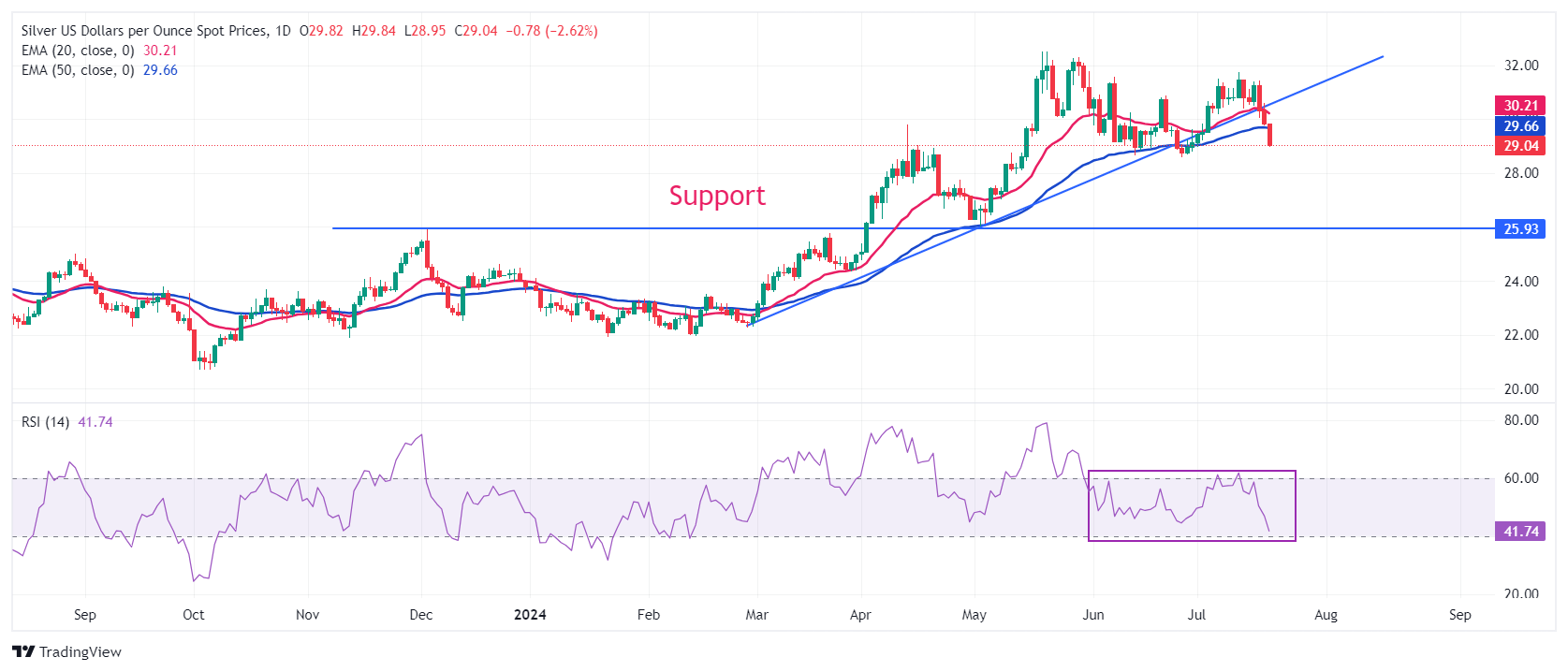- Analytics
- News and Tools
- Market News
- Silver Price Forecast: XAG/USD nosedives to near $29 as China offers sluggish fiscal boost
Silver Price Forecast: XAG/USD nosedives to near $29 as China offers sluggish fiscal boost
- Silver price plummets to near $29.00 on absence of big boost economic measures from China.
- Higher US Dollar due to expectations of Trump’s victory in US presidential elections has weighed on the Silver price.
- Silver price plunges after a decisive break below advancing trendline.
Silver price (XAG/USD) plummeted to near $29.00 in Friday’s American session. The white metal faces an intense sell-off as the outcome of China’s third plenum meeting had less stimulus measures to address economic challenges and was more focusing more on “high-quality development”.
World’s second-largest economy struggles to maintain the economic growth momentum due to poor demand from domestic and the overseas market. Therefore, investors were expecting big bold fiscal measures China’s Communist Party to uplift growth prospects.
Absence of strong fiscal measures to boost industrial output has weighed on the Silver price. The application of Silver, as a metal, has application in various sectors such as Electric Vehicles, medical appliances and consumer durables.
Meanwhile, a sharp recovery in the US Dollar (USD) due to growing speculation for Donald Trump’s victory in upcoming United States (US) presidential elections has also weighed on the Silver price. The US Dollar Index (DXY), which tracks the Greenback’s value against six major currencies, advances to near 104.30 after recovering from an almost four-month low of 103.65. Improved appeal of the US Dollar makes the Silver price an expensive bet for investors.
However, the Federal Reserve (Fed) is widely anticipated to start reducing interest rates from the September meeting. The expectations rose by cooling inflationary pressures and easing labor market strength.
Silver technical analysis
Silver price extends its losing streak for the third trading session on Friday. The white metal weakens after a breakdown below the upward-sloping trendline plotted from February 28 low at $22.28. The asset has dropped below the 20- and 50-day Exponential Moving Averages (EMAs), which trade around $30.20 and $29.66, respectively, suggesting that the near-term trend has turned bearish.
On the downside, 4 December 2023 high at $25.90 will be a major support zone for the Silver price.
The 14-day Relative Strength Index (RSI) oscillates in the 40.00-60.00 range, suggesting a sideways trend.
Silver daily chart
Silver FAQs
Silver is a precious metal highly traded among investors. It has been historically used as a store of value and a medium of exchange. Although less popular than Gold, traders may turn to Silver to diversify their investment portfolio, for its intrinsic value or as a potential hedge during high-inflation periods. Investors can buy physical Silver, in coins or in bars, or trade it through vehicles such as Exchange Traded Funds, which track its price on international markets.
Silver prices can move due to a wide range of factors. Geopolitical instability or fears of a deep recession can make Silver price escalate due to its safe-haven status, although to a lesser extent than Gold's. As a yieldless asset, Silver tends to rise with lower interest rates. Its moves also depend on how the US Dollar (USD) behaves as the asset is priced in dollars (XAG/USD). A strong Dollar tends to keep the price of Silver at bay, whereas a weaker Dollar is likely to propel prices up. Other factors such as investment demand, mining supply – Silver is much more abundant than Gold – and recycling rates can also affect prices.
Silver is widely used in industry, particularly in sectors such as electronics or solar energy, as it has one of the highest electric conductivity of all metals – more than Copper and Gold. A surge in demand can increase prices, while a decline tends to lower them. Dynamics in the US, Chinese and Indian economies can also contribute to price swings: for the US and particularly China, their big industrial sectors use Silver in various processes; in India, consumers’ demand for the precious metal for jewellery also plays a key role in setting prices.
Silver prices tend to follow Gold's moves. When Gold prices rise, Silver typically follows suit, as their status as safe-haven assets is similar. The Gold/Silver ratio, which shows the number of ounces of Silver needed to equal the value of one ounce of Gold, may help to determine the relative valuation between both metals. Some investors may consider a high ratio as an indicator that Silver is undervalued, or Gold is overvalued. On the contrary, a low ratio might suggest that Gold is undervalued relative to Silver.
© 2000-2025. All rights reserved.
This site is managed by Teletrade D.J. LLC 2351 LLC 2022 (Euro House, Richmond Hill Road, Kingstown, VC0100, St. Vincent and the Grenadines).
The information on this website is for informational purposes only and does not constitute any investment advice.
The company does not serve or provide services to customers who are residents of the US, Canada, Iran, The Democratic People's Republic of Korea, Yemen and FATF blacklisted countries.
Making transactions on financial markets with marginal financial instruments opens up wide possibilities and allows investors who are willing to take risks to earn high profits, carrying a potentially high risk of losses at the same time. Therefore you should responsibly approach the issue of choosing the appropriate investment strategy, taking the available resources into account, before starting trading.
Use of the information: full or partial use of materials from this website must always be referenced to TeleTrade as the source of information. Use of the materials on the Internet must be accompanied by a hyperlink to teletrade.org. Automatic import of materials and information from this website is prohibited.
Please contact our PR department if you have any questions or need assistance at pr@teletrade.global.
















